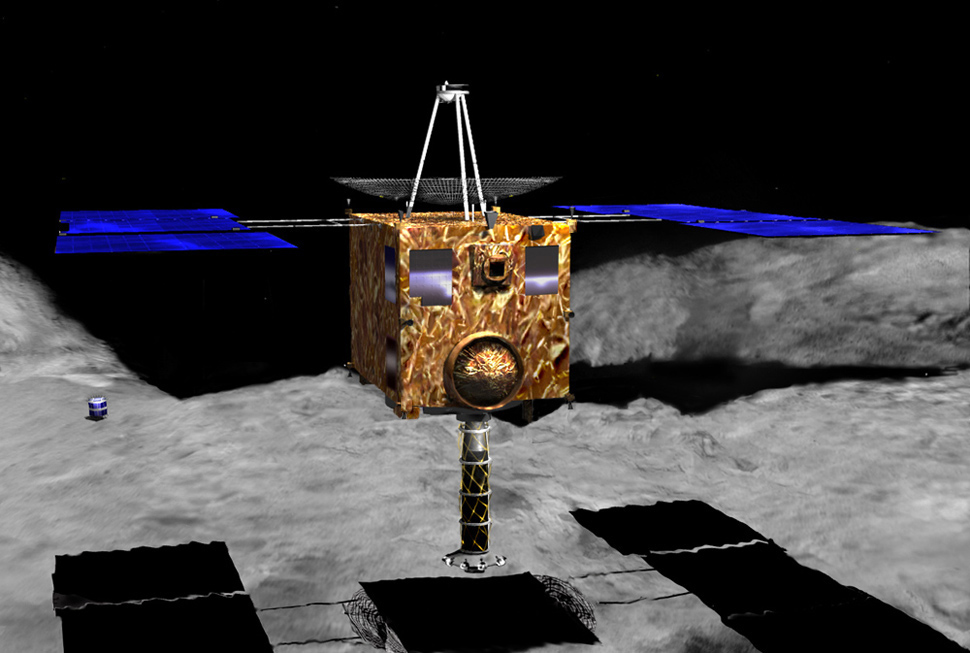|
XIPS
The gridded ion thruster is a common design for ion thrusters, a highly efficient low-thrust spacecraft propulsion method running on electrical power by using high-voltage grid electrodes to accelerate ions with electrostatic forces. History The ion engine was first demonstrated by German-born NASA scientist Ernst Stuhlinger, and developed in practical form by Harold R. Kaufman at NASA Glenn Research Center, NASA Lewis (now Glenn) Research Center from 1957 to the early 1960s. The use of ion propulsion systems were first demonstrated in space by the NASA Lewis SERT-1, Space Electric Rocket Test (SERT) I and II.J. S. Sovey, V. K. Rawlin, and M. J. Patterson, "Ion Propulsion Development Projects in U. S.: Space Electric Rocket Test 1 to Deep Space 1", ''Journal of Propulsion and Power, Vol. 17'', No. 3, May–June 2001, pp. 517–526. These thrusters used mercury as the reaction mass. The first was SERT-1, launched July 20, 1964, which successfully proved that the technology o ... [...More Info...] [...Related Items...] OR: [Wikipedia] [Google] [Baidu] |
Ion Thruster
An ion thruster, ion drive, or ion engine is a form of electric propulsion used for spacecraft propulsion. An ion thruster creates a cloud of positive ions from a neutral gas by ionizing it to extract some electrons from its atoms. The ions are then accelerated using electricity to create thrust. Ion thrusters are categorized as either electrostatic or electromagnetic. Electrostatic thruster ions are accelerated by the Coulomb force along the electric field direction. Temporarily stored electrons are reinjected by a ''neutralizer'' in the cloud of ions after it has passed through the electrostatic grid, so the gas becomes neutral again and can freely disperse in space without any further electrical interaction with the thruster. By contrast, electromagnetic thruster ions are accelerated by the Lorentz force to accelerate all species (free electrons as well as positive and negative ions) in the same direction whatever their electric charge, and are specifically refer ... [...More Info...] [...Related Items...] OR: [Wikipedia] [Google] [Baidu] |
Spacecraft Propulsion
Spacecraft propulsion is any method used to accelerate spacecraft and artificial satellites. In-space propulsion exclusively deals with propulsion systems used in the vacuum of space and should not be confused with space launch or atmospheric entry. Several methods of pragmatic spacecraft propulsion have been developed, each having its own drawbacks and advantages. Most satellites have simple reliable chemical thrusters (often monopropellant rockets) or resistojet rockets for orbital station-keeping, while a few use Reaction wheel, momentum wheels for attitude control. Russian and antecedent Soviet bloc satellites have used Spacecraft electric propulsion, electric propulsion for decades, and newer Western geo-orbiting spacecraft are starting to use them for north–south station-keeping and orbit raising. Interplanetary vehicles mostly use chemical rockets as well, although a few have used electric propulsion such as ion thrusters and Hall-effect thrusters. Various technologies ... [...More Info...] [...Related Items...] OR: [Wikipedia] [Google] [Baidu] |
Xenon Ion Propulsion System
An ion thruster, ion drive, or ion engine is a form of electrically powered spacecraft propulsion, electric propulsion used for spacecraft propulsion. An ion thruster creates a cloud of cation, positive ions from a neutral gas by ionizing it to extract some electrons from its atoms. The ions are then accelerated using electricity to create thrust. Ion thrusters are categorized as either electrostatics, electrostatic or electromagnetism, electromagnetic. electrostatics, Electrostatic thruster ions are accelerated by the Coulomb force along the electric field direction. Temporarily stored electrons are reinjected by a ''neutralizer'' in the cloud of ions after it has passed through the electrostatic grid, so the gas becomes neutral again and can freely disperse in space without any further electrical interaction with the thruster. By contrast, Electromagnetism, electromagnetic thruster ions are accelerated by the Lorentz force to accelerate all species (free electrons as wel ... [...More Info...] [...Related Items...] OR: [Wikipedia] [Google] [Baidu] |
ARTEMIS
In ancient Greek religion and Greek mythology, mythology, Artemis (; ) is the goddess of the hunting, hunt, the wilderness, wild animals, transitions, nature, vegetation, childbirth, Kourotrophos, care of children, and chastity. In later times, she was identified with Selene, the Lunar deity, personification of the Moon.Smiths.v. Artemis/ref> She was often said to roam the forests and mountains, attended by her entourage of nymphs. The goddess Diana (mythology), Diana is her Religion in ancient Rome, Roman equivalent. In Greek tradition, Artemis is the daughter of Zeus and Leto, and twin sister of Apollo. In most accounts, the twins are the products of an extramarital liaison. For this, Zeus' wife Hera forbade Leto from giving birth anywhere on solid land. Only the island of Delos gave refuge to Leto, allowing her to give birth to her children. In one account, Artemis is born first and then proceeds to assist Leto in the birth of the second twin, Apollo. Artemis was a kouro ... [...More Info...] [...Related Items...] OR: [Wikipedia] [Google] [Baidu] |
NEXT (ion Thruster)
The NASA Evolutionary Xenon Thruster (NEXT) project at Glenn Research Center is a Ion thruster#Gridded electrostatic ion thrusters, gridded electrostatic ion thruster about three times as powerful as the NASA Solar Technology Application Readiness, NSTAR used on Dawn (spacecraft), Dawn and Deep Space 1 spacecraft. It was used in Double Asteroid Redirection Test, DART, launched in 2021. Glenn Research Center manufactured the test engine's core ionization chamber, and Aerojet Rocketdyne designed and built the ion acceleration assembly. Purpose NEXT affords larger delivered payloads, smaller launch vehicle size, and other mission enhancements compared to chemical and other electric propulsion technologies for Discovery Program, Discovery, New Frontiers program, New Frontiers, Mars Exploration Program, Mars Exploration, and Flagship Program, Flagship outer-planet exploration missions. Design The NEXT engine is a type of solar electric propulsion in which thruster systems use the el ... [...More Info...] [...Related Items...] OR: [Wikipedia] [Google] [Baidu] |
ArianeGroup
ArianeGroup (formerly Airbus Safran Launchers) is an aerospace company based in France. A joint venture between Airbus and Safran, the company was founded in 2015 and is headquartered in Issy-les-Moulineaux near Paris. It consists of three core groups: aerospace, defence, and security. ArianeGroup has developed its next-generation two-stage Ariane 6 launch vehicle, which succeeded the Ariane 5 rocket, that had more than 110 launches. The new vehicle offers two variants that will be capable of carrying between 10,350 and 21,650 Kilogram, kilograms. The first launch of Ariane 6 occurred on 9 July 2024. If the company's task is to develop and manufacture the launch vehicles, Arianespace acts as the launch service provider for them. Meanwhile, another subsidiary, ArianeWorks, is tasked with developing next-generation technologies such as the reusable Themis rocket booster. ArianeGroup also notably manufactures France's M51 (missile), M51 thermonuclear weapon, nuclear submarine-laun ... [...More Info...] [...Related Items...] OR: [Wikipedia] [Google] [Baidu] |
European Retrievable Carrier
The European Retrievable Carrier (EURECA) was an uncrewed 4.5-tonne satellite with 15 experiments. It was a European Space Agency (ESA) mission and the acronym was derived from Archimedes' bathtub revelation " Eureka!". It was built by the German MBB-ERNO and had automatic material science cells as well as small telescopes for solar observation (including x-ray). It was launched 31 July 1992 by during STS-46, and placed into an orbit at an altitude of . EURECA was retrieved on 1 July 1993 by during STS-57 and returned to Earth. It was designed to fly five times with different experiments but the following flights were cancelled. EURECA is one of the few uncrewed space vehicles that have been returned to the Earth unharmed. It has been on display at the Swiss Museum of Transport in Lucerne since 2000. Design EURECA was made of high-strength carbon-fiber struts and titanium nodal points joined together to form a framework of cubic elements. Thermal control on EURECA combined ... [...More Info...] [...Related Items...] OR: [Wikipedia] [Google] [Baidu] |
Electrostatic Ion Thruster-en
Electrostatics is a branch of physics that studies slow-moving or stationary electric charges. Since classical times, it has been known that some materials, such as amber, attract lightweight particles after rubbing. The Greek word (), meaning 'amber', was thus the root of the word ''electricity''. Electrostatic phenomena arise from the forces that electric charges exert on each other. Such forces are described by Coulomb's law. There are many examples of electrostatic phenomena, from those as simple as the attraction of plastic wrap to one's hand after it is removed from a package, to the apparently spontaneous explosion of grain silos, the damage of electronic components during manufacturing, and photocopier and laser printer operation. The electrostatic model accurately predicts electrical phenomena in "classical" cases where the velocities are low and the system is macroscopic so no quantum effects are involved. It also plays a role in quantum mechanics, where additional t ... [...More Info...] [...Related Items...] OR: [Wikipedia] [Google] [Baidu] |
GOCE
The Gravity Field and Steady-State Ocean Circulation Explorer (GOCE) was the first of European Space Agency, ESA's Living Planet Programme satellite, heavy satellites intended to map in unprecedented detail the Earth's gravity field. The spacecraft's primary instrumentation was a highly sensitive gravity Gravity gradiometry, gradiometer consisting of three pairs of accelerometers which measured gravitational gradients along three orthogonal axes. Launched on 17 March 2009, GOCE mapped the deep structure of the Earth's Mantle (geology), mantle and probed hazardous volcanic regions. It brought new insight into ocean behaviour; this in particular, was a major driver for the mission. By combining the gravity data with information about sea surface height gathered by other satellite altimeters, scientists were able to track the direction and speed of Geostrophic current, geostrophic ocean currents. The low orbit and high accuracy of the system greatly improved the known accuracy and s ... [...More Info...] [...Related Items...] OR: [Wikipedia] [Google] [Baidu] |
Aerojet
Aerojet was an American rocket and missile propulsion manufacturer based primarily in Rancho Cordova, California, with divisions in Redmond, Washington, Orange and Gainesville in Virginia, and Camden, Arkansas. Aerojet was owned by GenCorp, Inc., In 2013, Aerojet was merged by GenCorp with the former Pratt & Whitney Rocketdyne to form Aerojet Rocketdyne. History Aerojet developed from a 1936 meeting hosted by Theodore von Kármán at his home. Joining von Kármán, who was at the time director of Guggenheim Aeronautical Laboratory at the California Institute of Technology, were a number of Caltech professors and students, including rocket scientist and astrophysicist Fritz Zwicky and explosives expert Jack Parsons, all of whom were interested in the topic of spaceflight. The group continued to occasionally meet, but its activities were limited to discussions rather than experimentation. Their first design was tested on August 16, 1941, consisting of a small cylindrical s ... [...More Info...] [...Related Items...] OR: [Wikipedia] [Google] [Baidu] |
Hayabusa
was a robotic spacecraft developed by the Japan Aerospace Exploration Agency (JAXA) to return a sample of material from a small near-Earth asteroid named 25143 Itokawa to Earth for further analysis. ''Hayabusa'', formerly known as MUSES-C for Mu Space Engineering Spacecraft C, was launched on 9 May 2003 and rendezvoused with Itokawa in mid-September 2005. After arriving at Itokawa, ''Hayabusa'' studied the asteroid's shape, spin, topography, color, composition, density, and history. In November 2005, it landed on the asteroid and collected samples in the form of tiny grains of asteroidal material, which were returned to Earth aboard the spacecraft on 13 June 2010. The spacecraft also carried a detachable minilander, ''MINERVA'', which failed to reach the surface. Mission firsts NASA's ''Galileo'' and ''NEAR Shoemaker'' spacecraft had visited asteroids before, but the ''Hayabusa'' mission was the first one to return an asteroid sample to Earth for analysis. In addition ... [...More Info...] [...Related Items...] OR: [Wikipedia] [Google] [Baidu] |







